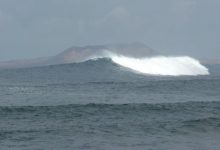A new Perth-based company thinks they have cracked the code when it comes to wave energy, a feat they sheet home to their experience in the offshore oil and gas industry.
WaveX is proving up a system that uses technology and supply chains that already service offshore oil and gas rigs, allowing them to cut costs and install it themselves, says founder Simon Renwick.
“We don’t have any underwater moving parts. That is fundamentally different to most other (wave) technologies, and that’s another big thing that makes us a much cheaper power producer than others,” he says.
Renwick says by using seabed tethers and anchors, and transmission cables already in use in other industries, and a system that produces all of the electricity above the waterline and not using the seabed as part of the generation design, they’ve cut costs to the point where they’re already cheaper than remote diesel generators.
“We’re already cheaper than remote area diesel and that’s our starting point. That’s how we get our foot in the market, and very quickly our costs start dropping to the point where we’re cheaper than offshore wind,” he says.
Provided WaveX can secure funding for its first real-world example, Renwick believes they could be generating revenue from a commercial international generator within three years.
That venture could be sourced through the $112.5 million US DOE wave energy grant, or with a South Pacific nation wanting to quit diesel.
How it works
The structure lies mainly underwater with a section above water where electricity is generated and sent onshore.
Three vertical steel cylinders are linked in a triangle formation and tethered to the seabed using anchors and chains, much like an offshore oil rig is, rather than relying on foundations. Inside each cylinder is another cylinder.
A full scale model uses 40m tubes with 30m of that length underwater, each about 12 m from each other in the triangular structure.
It means the whole, full scale, structure needs to be in at least 50m of water.
When waves hit the structure the two tubes move but with different rhythms – when one is moving upwards, the other may be moving downwards or on its way back up. This difference pushes magnets through coils installed along the upper part of the vertical cylinders.
The energy is turned into electricity via a linear generator.
Renwick believes the low profile design makes the WaveX power station more usable than a tall offshore wind turbine as it can be closer to shore, and it’s a good counterweight to summer-heavy generation of onshore wind and solar PV given wave activity is greater in the winter.
First real-world prototype coming
After winning a $2.5 million grant from the federal government, WaveX is now seeking to raise $3.5 million to get its first in-the-wild large scale prototype underway off the coast of Albany.
Subject to another final parcel of funding, the project will be in the water next year.
That generator will use 10m long tubes and have a 30 kW capacity, or about the same as a six residential homes.
Renwick says WaveX has had solid backing from Western Australia-based funders, including the government, which has clearly moved on from its experience with Carnegie Clean Energy.
In 2019, the state government suddenly pulled the plug on a state-sponsored $16 million, 20 MW flagship project, after funding Carnegie’s CETO technology for many years.
“Enough water has flown under the bridge [after Carnegie] and we’ve been successful in communicating to people that we have a different approach to wave technology and leveraging the oil and gas supply chain,” Renwick says.
“That has been the problem. People are inventing things that are brand new that don’t have a supply chain. We’ve probably accomplished in 15 months what it’s taken other people 15 years to get to.”







